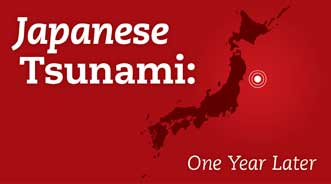Tsunami’s Wrath Reaches into Certified

When the devastating earthquake and tsunami hit Japan a year ago, it steamrolled into a global vehicle and electronics production crisis that touched almost every aspect of the car business.
And the aftermath was not just limited to the new-vehicle market. Even though these effects may not have been as widely talked-out or as obvious, the trickle-down nature of the auto industry led to a real impact for the certified pre-owned side of the market, as well.
“It’s a chain reaction, especially when we were unable to keep our new-car inventories at levels that we needed them to be to do the numbers we needed to do,” said Tammy Darvish of the DARCARS dealership group that counts Lexus, Nissan, Scion and Toyota stores among its various franchises.
“It will not only reduce the number of trades, but reduce the ability of several fleet accounts to flip their fleets,” she added.
With this in mind, Auto Remarketing reached out to dealers like Darvish, as well as automakers to gauge the degree to which the fallout from the tsunami influenced their CPO business.
"Delayed Reaction"
At McEleney Autocenter and McEleney Autoplex in Iowa — which includes a Toyota franchise — the impact to CPO wasn’t immediate, but it was powerful nonetheless. In fact, president John McEleney noticed “a delayed reaction” that would end up exacerbating the CPO supply shortage.
“The immediate impact wasn’t that great because we had vehicles in stock. There was inventory in the field. It was kind of a normal situation (supply-wise) just like we more or less have today,” said McEleney, who was 2009 chairman of the National Automobile Dealers Association.
“We didn’t have shortages for a while. Really the worst shortages came more in the September-October time frame. So, it was kind of a delayed reaction,” he continued.
The supply from the program-car side was already out there as certifiable inventory, McEleney explained, “but you didn’t have as many people buying new Toyotas, so you didn’t have the source of ’08-model trades … And then you also had more demand for CPO because there wasn’t as good of a supply of new units. So you had a couple things at work.”
Immediate Change
While McEleney said his dealership experienced more of a delayed response, one California Toyota dealer, in particular, noticed a change right away.
“There was an immediate uptick in CPO purchases with fears of new-car inventory shortages coming. The market was already strong to begin with, as a residual effect from the recalls that impacted us a year prior,” explained Aaron Misajon, who is the new-car sales director at Longo Toyota in El Monte, Calif.
“Supply was tight and prices were high. The tsunami elevated it that much more, and dealers immediately started stocking their used-car inventories,” added Misajon, who had been pre-owned sales manager at the dealership for several years before his recent appointment to the new-car position.
Tough Times at Auction
And some of the CPO fallout wasn’t so obvious, but it impacted the market nonetheless. One trend that Misajon noticed led to a bit of wholesale loss for his store.
“There were some dealers more aggressive than others who may have over-reacted in purchasing too many cars,” he explained. “As we saw the new car inventory gradually increase, these dealers — including ourselves to a certain degree — were stuck with some higher-priced CPO vehicles that we had a tough time getting rid of. This resulted in some wholesale loss.”
The pinch in the auction lanes was something that Subaru dealers were apparently noticing too, according to Jim Sarchese, who is the national product manager for Subaru Added Security and certified pre-owned.
And the amount of CPO-worthy units in the wholesale market is still down significantly, he said.
“For Subaru, the devastating tsunami brought our new-car supply chain down to a trickle last year, and as a result, dealers moved toward CPO in an attempt to offer customers some type of alternative, as nobody really knew how long it would be before production recovered,” he explained.
“Even though CPO prices went up over 10 percent at auction from March-November 2011, dealers rightfully pursued those vehicles to retain their customers,”
Sarchese continued. “This year CPO eligible inventory at auction is still down over 50 percent from pre Tsunami levels — and won’t begin to recover until Q4 2012 — so supply remains our main headwind in growing the program.”
Over in the leadership of Toyota’s certified program, Tom DeLuise said his dealers had to turn to alternative avenues for finding CPO-worthy vehicles outside of trade-ins. Despite the challenge, though, the automaker still managed to have its best year ever for CPO.
“When the dealers began to feel the effect of the drop in new car volume, it did effect their trade- in volume which in turned translated to a drop in vehicles available for certification. Our dealers are very resourceful and found other ways of sourcing cars,” he noted. “While Toyota obviously still had new cars available for sale, dealers focused on sourcing cars from many other areas such as their service lanes and contacting private party sales.
“These became sources of quality cars for certification. In addition, they took advantage of our Toyota Financial Services on-line sales, as well as vehicles that are traditionally purchased from live auctions,” DeLuise.
“We need to give our dealers all the credit for our TCUV performance in 2011. In what should have been a dismal year with regards to finding quality cars from a certification perspective, Toyota Certified sold an all-time record 331,797 vehicles,” he continued.
Impact on Non-Japanese Brands
Granted, the bulk of the impact was concentrated among the Japanese brands. Most of non-Japanese automakers responding to Auto Remarketing for this story said their CPO operations weren’t impacted in the storm’s aftermath.
That said, Darvish did notice a rather widespread impact.
“It wasn’t just our Japanese manufacturers that were affected,” said Darvish, whose group also has several Big 3, Korean and European stores. “A lot of our manufacturers were affected because of parts suppliers that were affected.”
Scott Weitzman, who heads up Volkswagen’s CPO program, noted: "There was not much of a direct impact on VW CPO. We did see all-time high market share figures through the spring and summer months, though."
Progress Made
As Subaru’s Sarchese alluded to, there are still challenges ahead and there are varying degrees of recovery when it comes to the inventory situation.
“We’ve really been at a tight, tight situation since within six months of the end of Cash for Clunkers,” Darvish said. “Between that and the leasing (drop-off), that’s all hitting us at one time now. A lot of what we’re experiencing is not just because of the tsunami.”
Over at Longo Toyota, Misajon said supply is “getting back to normal” at his store, and McEleney echoed much of the same.
“We’re in good shape. For new inventories, they’ve ramped production up, so they’re pretty normal. And we seem to be able to get all the new-car volumes improved, the trade-ins have improved, creating some inventory,” McEleney noted.
“I think the availability of used Toyotas is pretty solid. There is still a pretty strong demand, but if we’re willing to pay the price, we can get it. I think we’re over the hump from both a new and CPO standpoint,” he continued.
To reach Part I of Auto Remarketing’s series on the tsunami’s impact, visit http://www.autoremarketing.com/trends/tsunami-remembered-unforgettable-mark.


